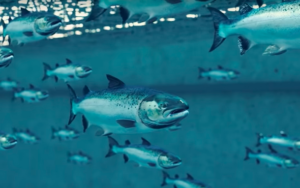
On a projection screen in front of a packed room in a coastal Maine town, computer-animated salmon swim energetically through a massive oval tank. A narrator’s voice soothingly points out water currents that promote fish exercise and ideal meat texture, along with vertical mesh screens that “optimize fish densities and tank volume.” The screens also make dead fish easy to remove, the narrator cheerily adds.
The video is part of a pitch made earlier this year for an ambitious $500-million salmon farm that Norway-based firm, Nordic Aquafarms, plans to build in Belfast, Maine, complete with what Nordic says will be among the world’s largest aquaculture tanks. It is one of a handful of projects in the works by companies hoping these highly mechanized systems will change the face fish farming—by moving it indoors.
If it catches on, indoor aquaculture could play a critical role in meeting the needs of a swelling human population, Nordic CEO Erik Heim says. He believes it could do so without the pollution and other potential threats to wild fish that can accompany traditional aquaculture—although the indoor approach does face environmental challenges of its own. “There’s always some risk, but the risk of the land-based system is a small percentage of the risk of an outdoor system,” says Michael Timmons, an environmental engineer at Cornell University who has studied aquaculture for more than 20 years and is not involved in the Nordic project.
I always was concerned in this subject and still am, thankyou for posting.
Thanks for your interest!
Comments are closed.